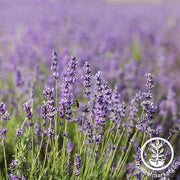Common English Lavender Herb Garden Seeds
Full Lavender Herb Growing Guide Instructions
Common English Lavender Herb Growing Habits
Non-GMO (Lavandula angustifolia) Common Lavender grows as a flowering herb reaching 20-24" tall with shrub-like growth. As a perennial, lavender blooms from spring throughout the summer. Once your plants reach full maturity, Common English Lavender develops fragrant purple-flower spikes on top of slender green stems with vigorous growth"giving off an earthy, minty aroma. Lavender continues growing throughout the warm season, before it goes to seed and overwinters. Lavender is a hardy variety that can stay planted through winter standing as a snow-covered herb which blooms by next spring.
The Medicinal Benefits of Common English Lavender Garden Herb
As a member of the mint family with fragrant flowers and leaves, Lavender is used medicinally, due to its antioxidants and herbal properties which can be made into essential oil"helping calm the nerves and anxiety. The earthy scent of Lavender also helps with sleep and is a soothing aromatherapy. Common Lavender also contains antiseptic oils that can be applied topically to aid skin irritations.
The Ornamental Uses of Growing Common English Lavender Herb & Seed
As a perennial flowering herb, Common English Lavender makes a fragrant bouquet and soothing herb. Add fresh sprigs of lavender to floral arrangements or dry the herb to use as potpourri. You can also pick the minty purple flowers to make lavender sachets to freshen up any room!
English Lavender Garden Herb Seeds Per Package
- 500 mg - Approximately 400 Seeds
- 1/4 oz - Approximately 6,575 Seeds
- 1 oz - Approximately 26,300 Seeds
- 4 oz - Approximately 105,200 Seeds
- 1 lb - Approximately 420,800 Seeds
It is very common for lavender seeds to have low germination in general. Since lavender is a perennial plant, its energy is put into keeping itself and its root structure alive; unlike annuals that are primed for seed production perennials are not. So, their germination rate tends to be lower.
For the best germination, lavender seed needs cold stratification. Place seed on a moist paper towel, roll and seal in a Ziploc bag. Place in the back of the refrigerator for about one month. Check once a week and moisten the paper towel as needed. You may carefully remove seed as it germinates and plant in a sterile seeding mix. At the end of the stratification period, plant remaining seed and barely cover as light aids in germination. You should see growth in 14 to 30 days. Transplant seedlings when they have two sets of the true leaves using the same seeding mix. Lavender doesn't like to be water-logged so watch your watering carefully and supply a strong light source.
Although commonly known as English lavender, Lavandula angustifolia is actually native to the cool Mediterranean nations of Spain, France, Italy, and Croatia. This "true lavender" variety is commercially planted for harvesting its oils for use in perfumes and essential oils. The species was once classified as Lavandula officinalis, the species name officinalis referring to its medicinal properties. However, the species was reclassified as angustifolia, which is simply translated from Latin meaning "narrow leaf."
















